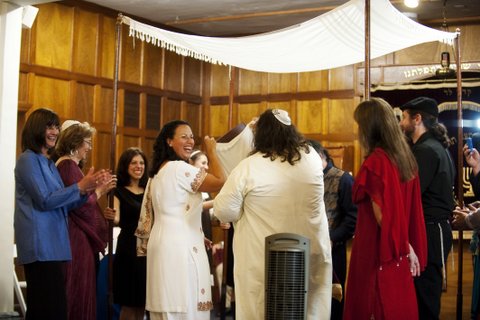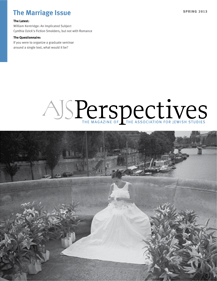
For some, the response has been to seek ways in which to give the bride a more active role, such as suggesting responses she can make to actively indicate her acceptance of the kiddushin. Many Orthodox decisors, and even some Conservative ones, discourage the bride from presenting a ring to the groom during the ceremony, ruling that this turns the transaction into an equal exchange and nullifies the groom’s acquisition of her, but some permit it if a sufficient separation is made between the two acts or if the bride makes no reciprocal statement “acquiring” the groom. Indeed, while such mutualized statements—i.e., each participant declares the other “set aside”—may reflect the actual expectations of the couple for a union of sexual and emotional exclusivity on both sides, it does not typically follow that they will have control over the legal meaning given to the mutual kiddushin. Even some of the decisors who permit mutual statements limit their legal scope. Consider, for example, the view expressed by Rabbi Isaac Klein, a legal authority of the Conservative Movement: “Some authorities object . . . especially if the formula used by the bride is the same as the one used by the groom. Legally, however, there can be no objection. Once the traditional formula has been recited the betrothal is binding, and whatever is added is of no legal significance” (Isaac Klein, A Guide to Jewish Religious Practice [Jewish Theological Seminary of America , 1979], 396; emphasis added). It is still the case within both Conservative and Orthodox practice that when a marriage ends the man will be required to give the woman a get, regardless of whether “mutual” kiddushin took place; she is not required or able to give him a get instead or in return.
The question for those who wish to proceed in an egalitarian direction (whether between different-sex or same-sex couples) while also taking into consideration the Jewish legal framework of marriage, is this: Can there be Jewish marriage without unilateral kiddushin? Is a marriage still recognized as Jewish if kiddushin is reconfigured to be mutual and the harmful effects of its unilateral nature are legally neutralized, or enacted through a different method altogether? I’d like to suggest that there are three approaches currently being pursued, while also noting that the categories are likely to change, develop, and grow over time.
(1) Make kiddushin mutually binding and/or legally neutralize the harmful effects of its unilateral nature.
What these proposals have in common is recourse to the legal mechanisms of conditional kiddushin; each embeds conditions into the kiddushin declarations that are meant to make the statements of the two parties provisional upon each other. The topic is complex, but it should be stated that most Orthodox authorities do not accept the validity of such conditions, on the understanding that living together in marriage cancels out conditions of betrothal. Conditional kiddushin is accepted in the Conservative Movement. In Jill Jacobs and Guy Austrian’s proposal (Conservative Judaism 63:3), each party makes the kiddushin contingent on the other’s willingness to be obligated by the terms of the egalitarian ketubah, marriage contract, which they draft; each also invites the other to “be my life partner” rather than using language of kiddushin. Whether this is mutual kiddushin or a form of kiddushin that makes explicit the need for female consent is not entirely clear, nor is it clear that a new format would be necessary for dissolving this kiddushin or whether the woman could dissolve the kiddushin herself by subsequent removal of her consent to the conditions. The authors also note, “our ceremony seeks to solve problems of patriarchy and sexism in kiddushin between a man and a woman, and therefore does not necessarily address the particular needs of same-sex couples” (40).
A proposal on the blog “Mah Rabu,” on the other hand, explicitly aims to create mutual kiddushin, with conditions built into the statements each party makes to the other such that one kiddushin should not go into effect (or stay in effect) unless the other does also, and vice versa. In regards to divorce, if one of the parties chooses to terminate his/her act of kiddushin, then the condition on which the other person’s act of kiddushin rests is no longer valid. This format would also appear to be applicable to a marriage of same-sex partners, since unlike in classical halakah, it presumes that kiddushin is a process that may be performed by and binding on persons of either gender.
(2) Use a formula that does not create kiddushin legally, but which preserves something of the language and/or appearance of kiddushin.
These two proposals come from very different ideological perspectives and have different intent, yet use similar means. Both attempt to mimic the appearance and even some of the assumptions of marriage through kiddushin, while also deliberately seeking to avoid creating actual legal bonds of kiddushin.
Meir Simha Feldblum (Dine Yisrael XIX) writes from an Orthodox Israeli perspective, to address the social problems of agunot (women whose husbands withhold divorces) and mamzerim (children born to “adulterous” unions, as when the mother’s prior marriage was not severed by a proper get and is therefore considered still in force under Jewish law). Those in these situations have limited (mamzerim) or no (agunot) marriage options under Jewish law. He further notes that many modern, non-Orthodox women would reject the premises of kiddushin were such premises fully understood. Thus, while he continues to privilege kiddushin as the optimal form of marriage, he proposes that marriage done “in the manner of kiddushin” be allowed into the legal system as a new form of valid connection. In such a ceremony the groom would use the words “harei at m’yuhedet li” (behold, you are singled out for me), a formula which is mentioned in bKiddushin 6a and later codes as only doubtfully creating kiddushin and hence not, he argues, demanding a get to be severed. Although the couple foregoes the acquisitional nature of kiddushin and the unilateral divorce process, the ceremony as Feldblum imagines it is still hardly egalitarian.
David Greenstein (G’vanim 5) argues for a more thorough-going rejection of kiddushin in its traditional form, as it relies on a “theory of marriage” very different from that held by most modern couples. His rejection of mutualizing traditional kiddushin rests also on legal grounds, in keeping with the view of Issac Klein, cited earlier. He does, however, embrace the concept of exclusivity that kiddushin represents, “the sense of exclusive ‘ownership’ that is inherent in feeling love for another should be preserved and acknowledged—as a feeling and claim that each is entitled to have regarding the other.” Like Feldman, he also turns to a form of marital declaration mentioned, but explicitly rejected as nonbinding, in rabbinic and later halakic writings. On this basis he proposes a ceremony in which each partner (of any gender combination) does not attempt to “acquire” the other, but rather makes a statement of his/her own change of status: “Behold, I betroth myself to you.”
(3) Replace kiddushin entirely with another legal model.
Rachel Adler, in Engendering Judaism, states that kiddushin and the metaphor of ownership cannot be redeemed. While she holds that two “reciprocal” acts of kiddushin ought to legally cancel each other out, nonetheless “it commodifies human beings. The groom’s commodification and acquisition of the bride is not rectified by the bride’s retaliation in kind” (191). Rather, a new ceremony with a new legal basis is needed. Adler turns to rabbinic discussions of the formation of business partnerships, known in mishnaic and Talmudic passages as “placing [money] in a pouch,” to create a ceremony she names “B’rit Ahuvim,” “Lover’s Covenant.” In this ceremony each of the two partners (of any gender combination) places an item of value—a ring or something else chosen for its significance to the participant—into a bag and lift the bag together, thereby each acquiring rights and responsibilities in the partnership.
The concerns that remain are several. Allow me to highlight two, which are interrelated. Both hinge on the impulse among decisors of Jewish law (and other legal systems) to assimilate new cases and unfamiliar acts into already established categories. First, the closer an alternative ceremony looks to traditional kiddushin, the more likely that it will be assimilated by traditionalist authorities under the rubric of kiddushin, such that a get will be required to sever it. . . .
The author of the Mah Rabu blog, however, questions whether one ought to be concerned about legal meanings imposed from outside, at the expense of creating one’s own egalitarian legal meanings. A second question follows: If not deemed kiddushin, such connections may still be absorbed into the traditional system under other definitions, such as licentiousness, or even concubinage. If no get is demanded, then is this sufficient? Are negative, undesirable definitions imposed from outside relevant? To what extent do the authors of these proposals, and others that might follow in their wake, hope to create new legal meanings, and for whom?

